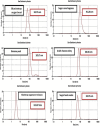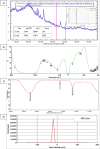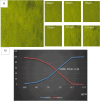Copper nanoparticles biosynthesis by Priestia megaterium and its application as antibacterial and antitumor agents
- PMID: 39384865
- PMCID: PMC11464900
- DOI: 10.1038/s41598-024-72598-3
Copper nanoparticles biosynthesis by Priestia megaterium and its application as antibacterial and antitumor agents
Abstract
The growth of material science and technology places high importance on creating better processes for synthesizing copper nanoparticles. Thus, an easy, ecological, and benign process for producing copper nanoparticles (CuNPs) has been developed using Priestia sp. bacteria utilizing a variety of low-cost agro-industrial wastes and byproducts. The biosynthesis of CuNPs was conducted using glucose medium and copper ions salt solution, then it was replaced by utilizing low-cost agro-industrial wastes. UV-visible spectroscopy, dynamic light scattering (DLS), X-ray diffraction (XRD), High-resolution transmission electron microscope (HR-TEM), Attenuated Total Reflectance and Fourier transform infrared (ATR-FTIR), and zeta potential were used to characterize the biosynthesized CuNPs. The cytotoxicity of CuNPs using Vero -CCL-81 cell lines, and antibacterial and antitumor properties using human colon epithelial colorectal adenocarcinoma Caco-2-HTB-37 cell lines were assessed. The UV-visible and DLS studies revealed CuNPs formation, with a maximum concentration of 6.19 ppm after 48 h, as indicated by a 0.58 Surface plasmon resonance (SPR) within 450 nm and 57.73 nm particle size. The 16S rRNA gene analysis revealed that Priestia sp. isolate is closely related to Priestia megaterium and has been deposited in the NCBI GenBank with accession number AMD 2024. The biosynthesis with various agro-industrial wastes indicated blackstrap sugar cane molasses being the most effective for reducing CuNPs size to 3.12 nm owing to various reducing and stabilizing active compounds. The CuNPs were free of contaminants, with a sphere-shaped structure and a cytotoxicity assessment with an IC50 of 367.27 μg/mL. The antibacterial activity exhibited by the most susceptible bacteria were Bacillus cereus ATCC 11788 and Staphylococcus aureus ATCC 6538 with inhibition zones of 26.0 mm and 28.0 mm, respectively. The antitumor effect showed an IC50 dose of 175.36 μg/mL. Based on the findings, the current work sought to lower product costs and provide a practical solution to the environmental contamination issues brought on by the buildup of agricultural wastes. In addition, the obtained CuNPs could be applied in many fields such as pharmaceuticals, water purification, and agricultural applications as future aspects.
Keywords: Priestia megaterium; Agro-industrial wastes; Antibacterial effect; Antitumor activity; Caco-2-HTB-37 cell line; Copper nanoparticles; Cytotoxicity activity.
© 2024. The Author(s).
Conflict of interest statement
The authors declare no competing interests.
Figures









Similar articles
-
Biological activities of optimized biosynthesized selenium nanoparticles using Proteus mirabilis PQ350419 alone or combined with chitosan and ampicillin against common multidrug-resistant bacteria.Microb Cell Fact. 2025 Jul 5;24(1):159. doi: 10.1186/s12934-025-02783-0. Microb Cell Fact. 2025. PMID: 40618114 Free PMC article.
-
Green-synthesized silver-copper nanocomposites from Sargassum latifolium: antibacterial, anticancer, and in silico pharmacokinetic evaluation.Med Oncol. 2025 Jul 16;42(8):339. doi: 10.1007/s12032-025-02899-8. Med Oncol. 2025. PMID: 40670822
-
In vitro assessment of the effect of magnetic fields on efficacy of biosynthesized selenium nanoparticles by Alborzia kermanshahica.BMC Biotechnol. 2024 May 9;24(1):27. doi: 10.1186/s12896-024-00855-4. BMC Biotechnol. 2024. PMID: 38725019 Free PMC article.
-
Management of urinary stones by experts in stone disease (ESD 2025).Arch Ital Urol Androl. 2025 Jun 30;97(2):14085. doi: 10.4081/aiua.2025.14085. Epub 2025 Jun 30. Arch Ital Urol Androl. 2025. PMID: 40583613 Review.
-
Phytogenic nanoparticles: synthesis, characterization, and their roles in physiology and biochemistry of plants.Biometals. 2024 Feb;37(1):23-70. doi: 10.1007/s10534-023-00542-5. Epub 2023 Nov 2. Biometals. 2024. PMID: 37914858 Review.
Cited by
-
Chromatographic fingerprinting and antibiofilm effect of Ziziphus jujuba fraction on Pseudomonas aeruginosa.AMB Express. 2025 May 21;15(1):79. doi: 10.1186/s13568-025-01886-6. AMB Express. 2025. PMID: 40397053 Free PMC article.
-
Recent advances in phyto- and microorganisms-mediated synthesis of copper nanoparticles and their emerging applications in healthcare, environment, agriculture and food industry.Bioprocess Biosyst Eng. 2025 Jul 9. doi: 10.1007/s00449-025-03196-4. Online ahead of print. Bioprocess Biosyst Eng. 2025. PMID: 40632213 Review.
-
Utilization of agro-industrial wastes and by-products by Bacillus subtilis for the biogenic synthesis and In-Depth characterization and cytotoxicity assessment of silver nanoparticles.BMC Microbiol. 2025 May 14;25(1):291. doi: 10.1186/s12866-025-03998-2. BMC Microbiol. 2025. PMID: 40369401 Free PMC article.
-
Sericin-Assisted Green Synthesis of Gold Nanoparticles as Broad-Spectrum Antimicrobial and Biofilm-Disrupting Agents for Therapy of Bacterial Infection.Int J Nanomedicine. 2025 Mar 19;20:3559-3574. doi: 10.2147/IJN.S494616. eCollection 2025. Int J Nanomedicine. 2025. PMID: 40125431 Free PMC article.
References
-
- Bhuyan, T. et al. Therapeutic potential of lipopeptide biosurfactant-fabricated copper oxide nanoparticles: Mechanistic insight into their biocompatibility using zebra fish. Curr. Res. Biotechnol.7, 100227. 10.1016/j.crbiot.2024.100227 (2023).
-
- Nair, G. M., Sajinia, T. & Mathewb, B. Advanced green approaches for metal and metal oxide nanoparticles synthesis and their environmental applications. Talanta open.5, 100080. 10.1016/j.talo.2021.100080 (2021).
-
- Kolahalam, L. A. et al. Review on nanomaterials: synthesis and applications. Mater. Today Proc.18(4), 2182–2190. 10.1016/j.matpr.2019.07.371 (2019).
MeSH terms
Substances
LinkOut - more resources
Full Text Sources
Medical
Molecular Biology Databases
Miscellaneous

